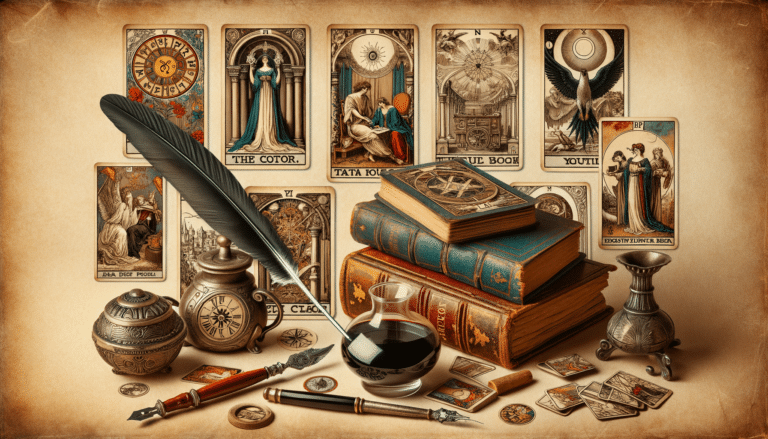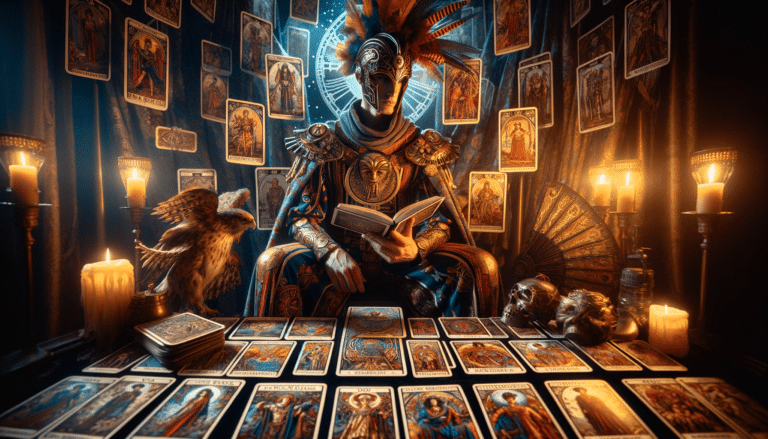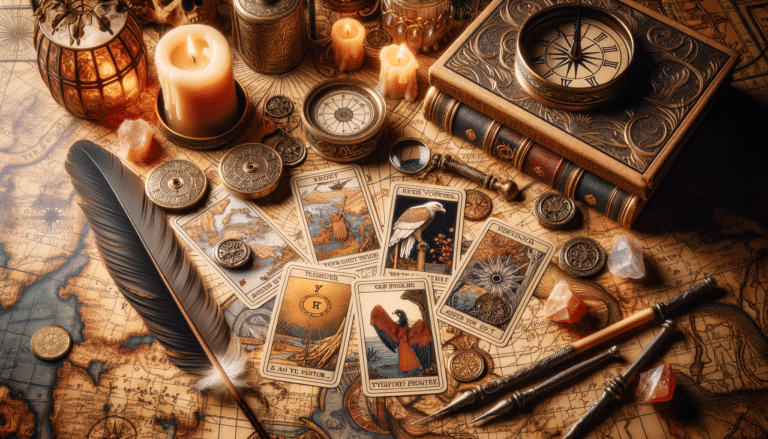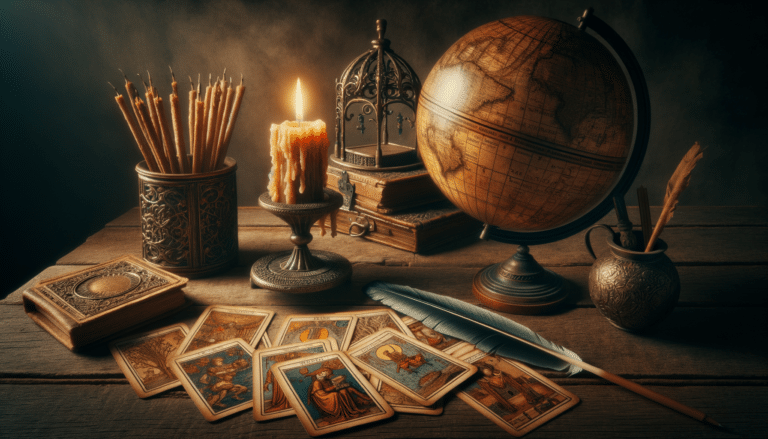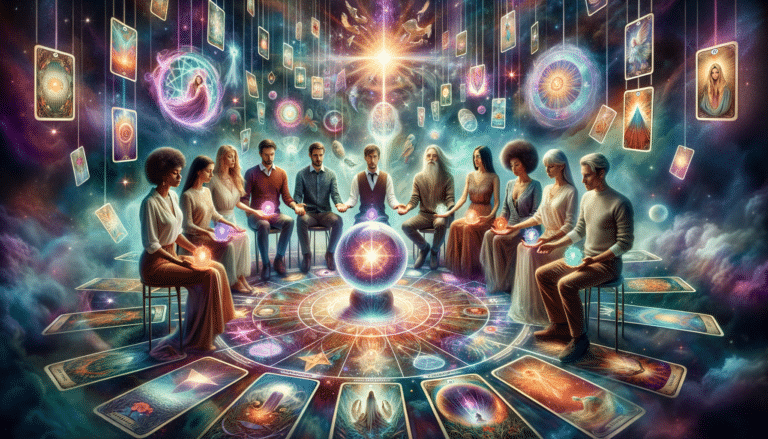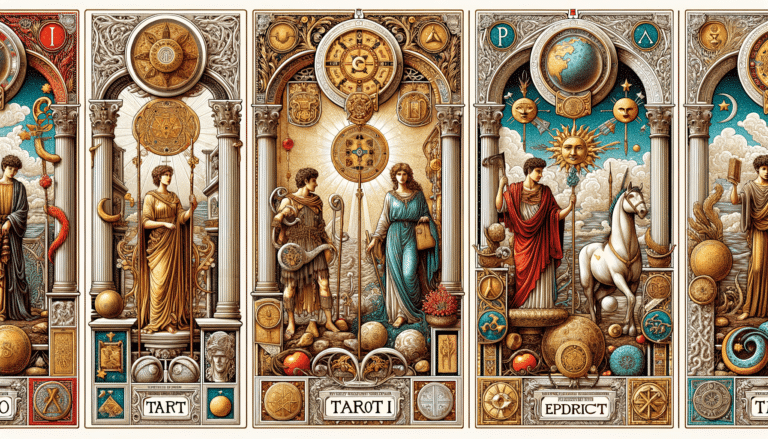Exploring Tarot Cards and Their Historical Roots: 13 Key Insights
You’re about to embark on an esoteric exploration of tarot cards and their historical roots, tracing their transformation from a Renaissance-era game to a tool for divination.
You’ll uncover the origins of tarot in the rich tapestry of medieval symbolism and its early use in the Italian courts.
As you delve into the depths of tarot’s past, you’ll connect the dots between the Mamluk card games and the intricate imagery favored by occult figures like Aleister Crowley.
You’ll witness the Victorian era’s influence on tarot and its surge in popularity during the 20th century, right up to its digital adaptation in modern times.
These 13 insights will guide you through the layered history of tarot cards, revealing how they’ve captivated and mystified generations.
Key Takeaways
- Tarot cards originated as playing cards in 15th-century Europe but transitioned into tools for divination and reflection.
- Tarot cards have deep roots in Renaissance art and symbolism, reflecting the allegorical works of Renaissance masters.
- Medieval symbolism is also present in tarot cards, offering insights into the medieval worldview and concepts such as fate and religious authority.
- Different tarot decks, such as the Marseille, Rider-Waite-Smith, and Thoth decks, have played significant roles in shaping the evolution and popularity of tarot cards throughout history.
Origins of Tarot Cards
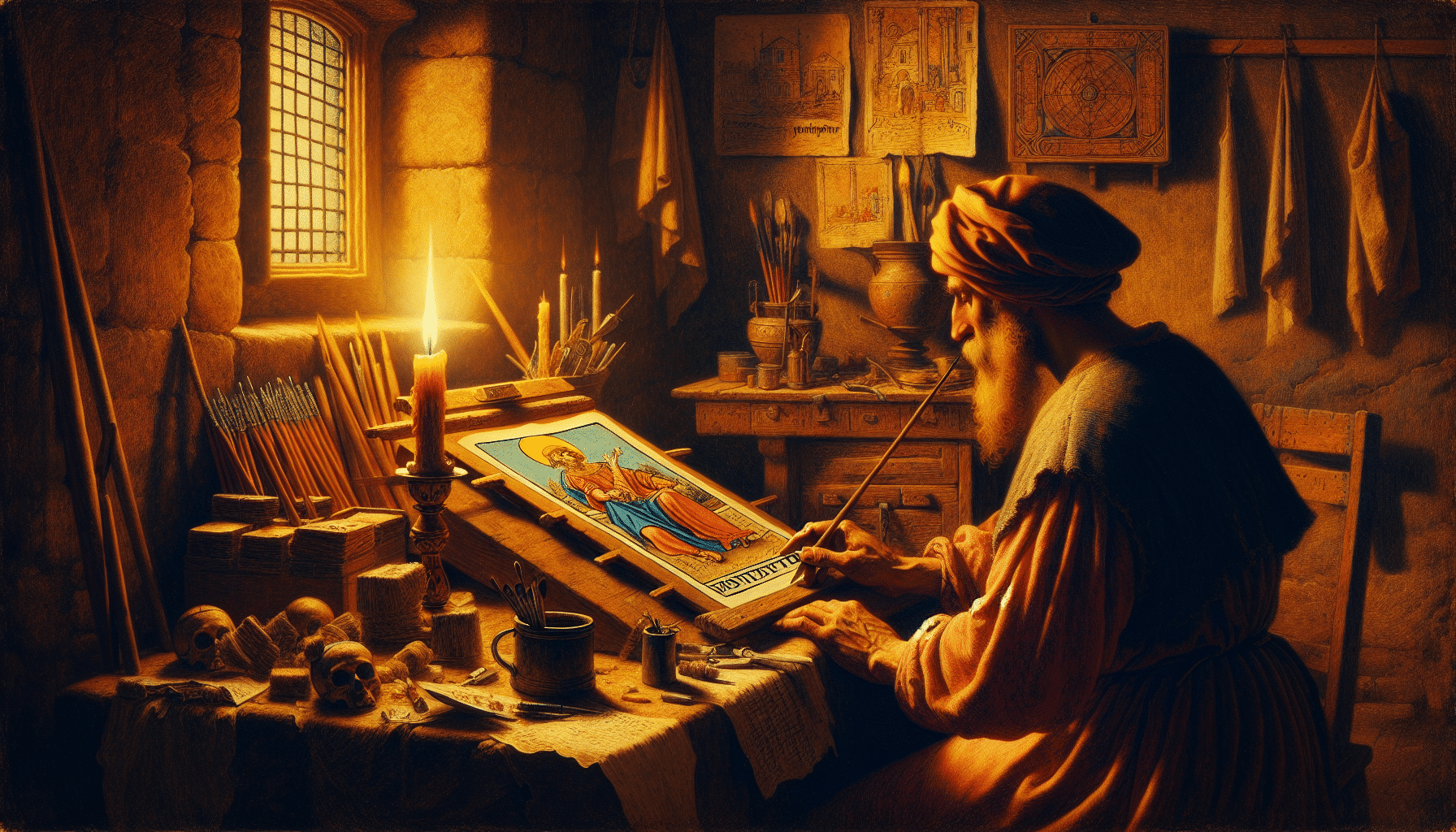
You’ll find that many tarot cards have their origins in 15th-century Europe where they were initially used for playing games rather than divination. This might surprise you if you’ve only seen tarot cards in the context of mystical fortune-telling. The card games origins are actually quite mundane; these decks were created for entertainment and social gatherings. It’s believed that the tarot was first conceived in Italy, with the oldest surviving cards dating back to the mid-15th century.
The transition from card games to mystical use likely began when the mysterious iconography of the cards captured the imagination of those seeking deeper meaning. The rich symbolism on the cards was ripe for interpretation, and over time, they became associated with the esoteric and the occult. You’re now witnessing a legacy that’s evolved from courtly game-play to a tool for exploring the subconscious.
It’s fascinating how the images on the tarot cards, once simply part of a game, have gained such significant spiritual and psychological importance. Each figure, object, and scene holds a myriad of interpretations that continue to intrigue and inspire many to this day.
Tarot’s Italian Renaissance Influence
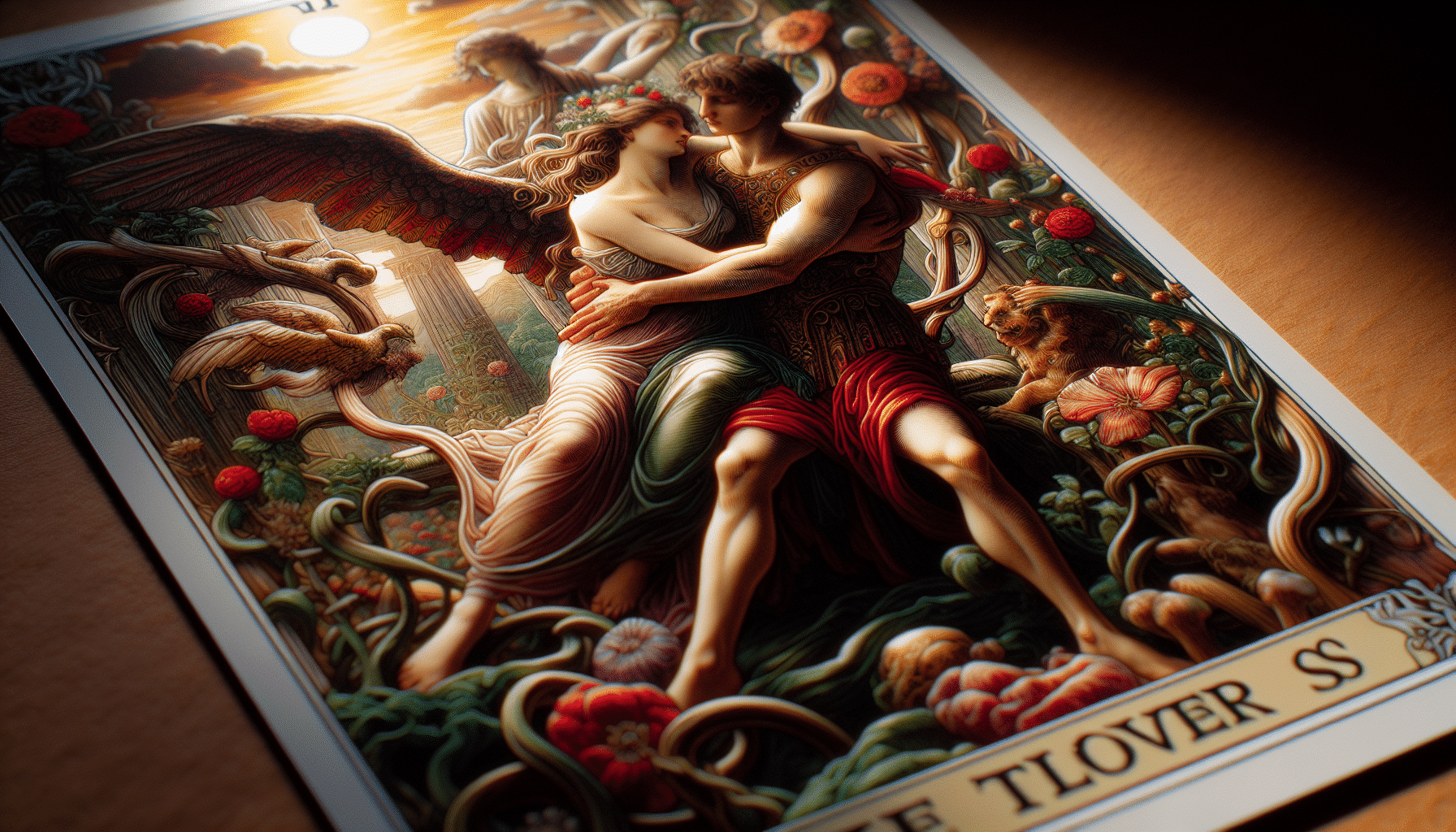
As you explore the history of tarot cards, you’ll find the Italian Renaissance’s mark undeniable, especially in the court cards. These cards bore symbols and figures directly influenced by the period’s rich artistic traditions.
You’ll discover how the elegant tapestry of Renaissance art gave tarot imagery layers of symbolic meaning.
Originating Court Cards
Tarot’s court cards, embodying the hierarchical structure of Italian Renaissance courts, reveal the period’s influence on the deck’s evolution. These cards reflect the courtly origins of tarot as not just playing cards but also as a representation of society’s upper echelons. You’ll find that the characters and symbols on these cards are steeped in the customs and governance of the time.
To create imagery in your mind:
- The King and Queen cards, draped in opulent Renaissance attire, commanding power and wisdom.
- The Knight cards, on horseback, symbolize chivalry and the pursuit of honor and adventure.
- The Page cards, often seen as messengers or squires, indicate messages and the potential for growth.
Through these images, you’ll gain a deeper appreciation for tarot’s rich historical tapestry.
Renaissance Art Symbols
Why not delve into the rich tapestry of Renaissance art to uncover how its symbols have profoundly shaped the imagery of tarot cards? The Italian Renaissance, a period of great cultural rebirth, significantly influenced tarot imagery with its use of religious and mythological motifs.
Unlike the earlier Gothic architecture, which was characterized by towering spires and intricate details, Renaissance art embraced a more humanistic approach, often depicting figures from classical mythology and Christian allegory with a newfound emphasis on naturalism.
This transition from medieval to Renaissance art parallels the evolution of tarot cards. The Symbolist movement, which sought to express ideas metaphorically through art, finds its echo in tarot’s intricate iconography. Each card’s symbolism is a gateway to understanding deeper truths, much like the allegorical works of Renaissance masters.
Check out our Tarot Cards & Oracle Decks here…
Tarot and Medieval Symbolism
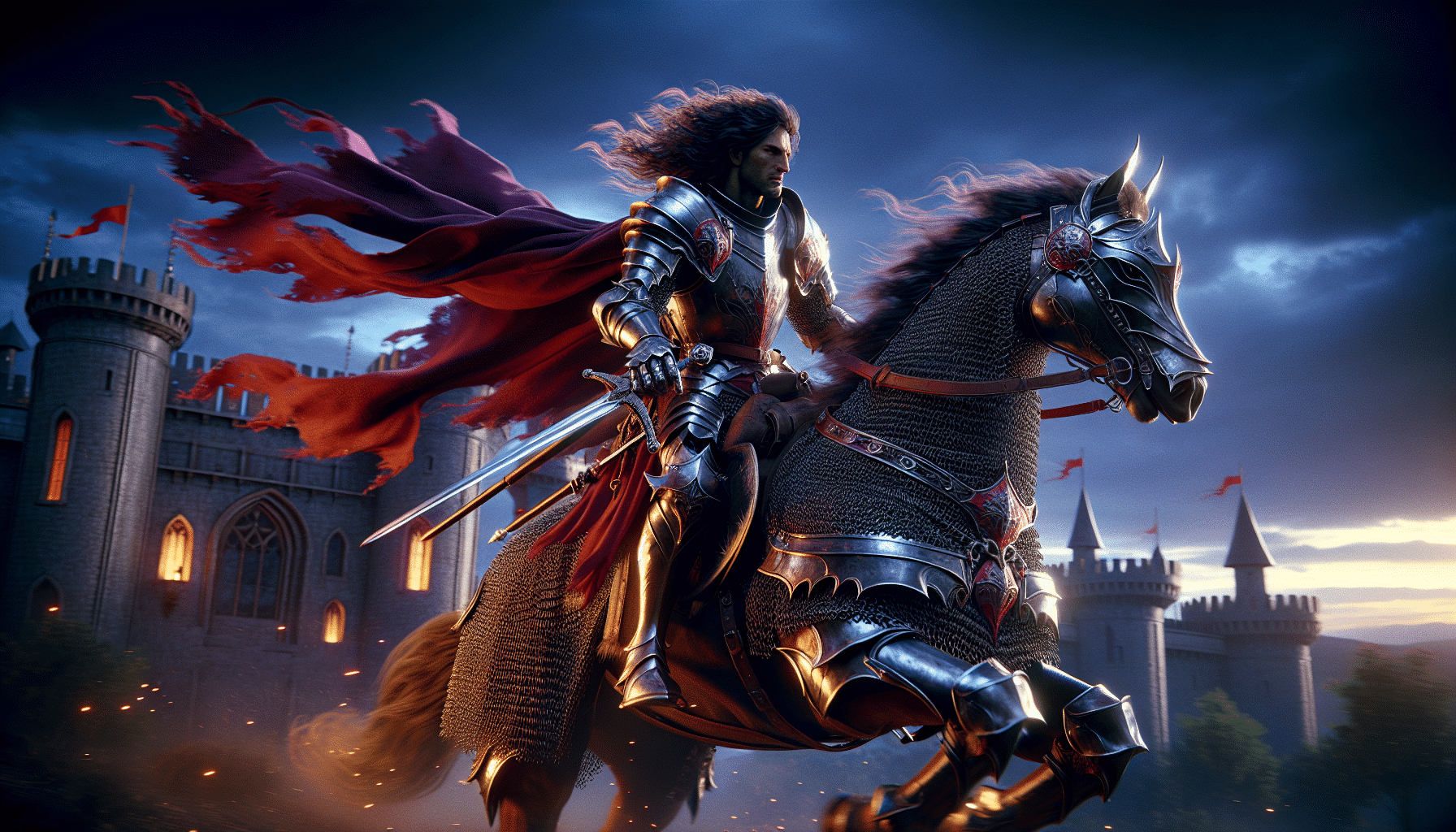
Within the intricate artwork of Tarot cards, you’ll find a tapestry of medieval symbolism that reflects the social and spiritual paradigms of the time. As you delve into the card interpretations, it becomes clear that the symbolic meanings are deeply entrenched in the culture of the Middle Ages. These symbols serve as a bridge to the past, providing you with insights into a world where the physical and metaphysical realms were closely intertwined.
To conjure up the imagery of medieval symbolism in Tarot cards, consider the following:
-
The Chariot card, which often signifies victory and determination, features a warrior in a chariot, embodying the feudal values of bravery and conquest.
-
The Hierophant, representing religious authority and traditional beliefs, is typically depicted as a religious figure akin to a pope, signifying the church’s paramount influence during medieval times.
-
The Wheel of Fortune card captures the medieval concept of fate and the cyclic nature of life, with its depiction of a wheel surrounded by various mythical and historical figures.
These symbols aren’t mere decorations; they’re keys to understanding the complex interplay between the medieval worldview and Tarot’s profound messages. Engaging with these symbols can enrich your perspective on the cards and their relevance to your own life.
Learn more with these tarot books here…
Transition From Game to Divination
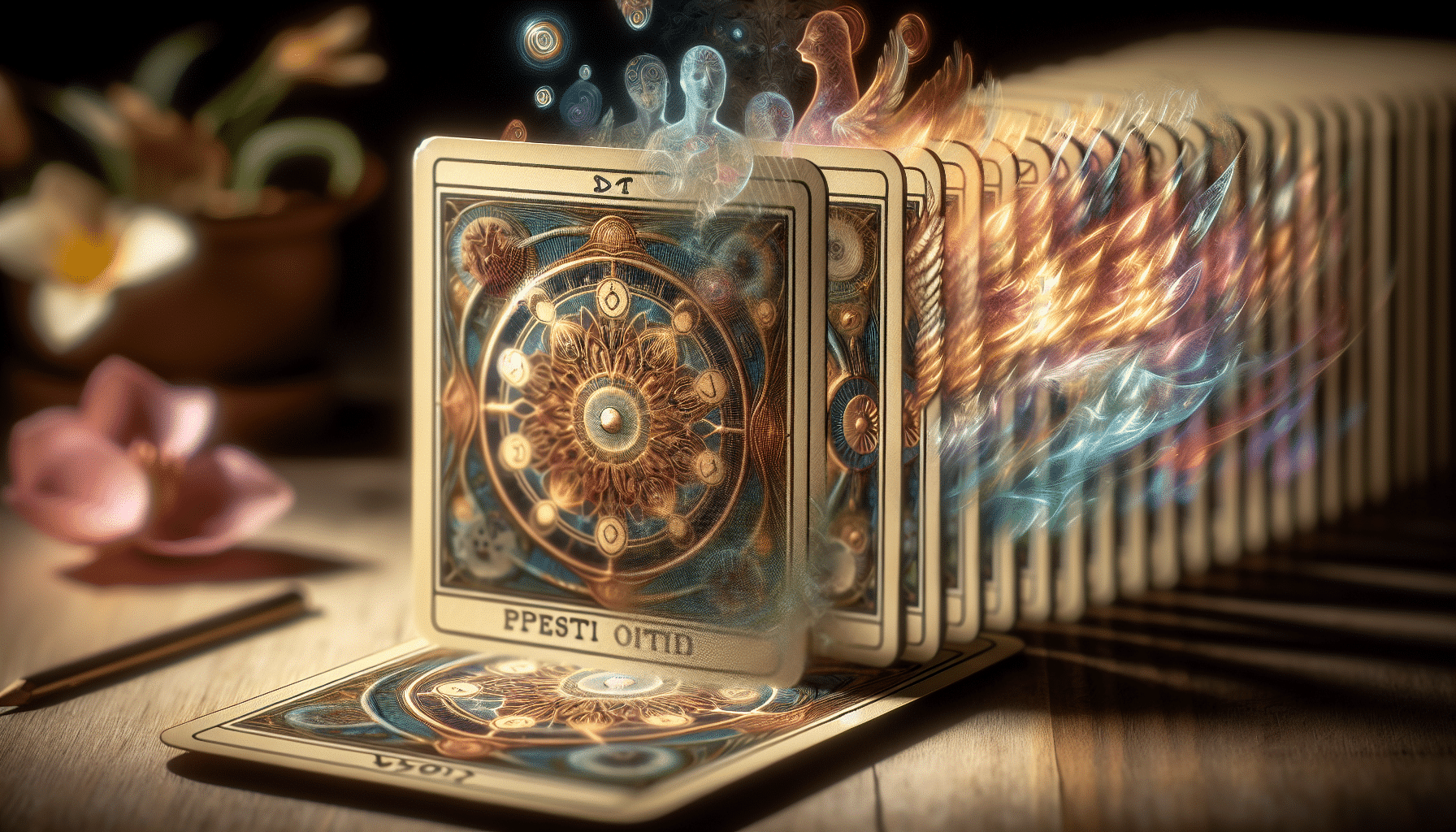
You’ve seen how tarot began as a medieval pastime, but now let’s explore how these cards shifted from entertainment to mystical guidance.
We’ll map out the timeline that marks the emergence of divination practices with tarot. Understand the transformation process as tarot’s use evolved to uncover hidden truths and futures.
Game to Guidance Shift
While you may initially associate tarot cards with their mystical reputation, it’s fascinating to delve into how they transitioned from parlor games to tools of divination. This shift wasn’t abrupt but a gradual intertwining of play and spirituality. It’s here that card interpretation took on a profound role, and reading ethics began to form.
Imagine the transformation through these vivid scenes:
-
A 15th-century European drawing room where aristocrats play tarot card games, laughing and jesting.
-
A dimly lit 18th-century salon where a fortune-teller lays out tarot cards, telling tales of future love and loss.
-
A modern-day practitioner who respectfully interprets each card, upholding ethics to guide seekers through life’s intricacies.
These moments capture the essence of tarot’s journey from game to guidance.
Divination Emergence Timeline
As you explore the tarot’s past, it’s clear that the 18th century marked a pivotal era when cards once used for games began revealing messages of destiny. The shift from playful pastime to profound divination tool wasn’t abrupt but evolved as mystical and esoteric interests grew.
Cardomancy origins are intertwined with these developments; as people sought new ways to understand the unknown, tarot cards became a key to unlocking potential futures.
Predictive practices with tarot gained traction, blending traditional symbolism with interpretations of life’s fortunes and challenges. You’re witnessing the unfolding of a centuries-old narrative where a simple deck transformed into a mirror of the soul, reflecting personal journeys and the broader human experience through its enigmatic imagery.
Usage Transformation Process
The transformation of tarot from a recreational game to a divinatory practice reflects a profound shift in societal attitudes towards the metaphysical.
As you delve into the history of tarot, you’ll notice:
-
Card collecting began as a pastime, with the tarot’s rich and intricate artwork lending itself to fascination and conversation.
-
Over time, an artistic interpretation of the cards’ imagery evolved, suggesting deeper meanings and symbols beyond their face value.
-
This led to the cards being used as tools for reflection, offering insights that many believe can unveil hidden aspects of the psyche or predict future events.
Your understanding of this evolution highlights how tarot’s allure transcends mere play, bridging the gap between art, psychology, and spiritual exploration.
Learn even more secrets of the history of tarot cards here…
Mamluk Card Game Connections
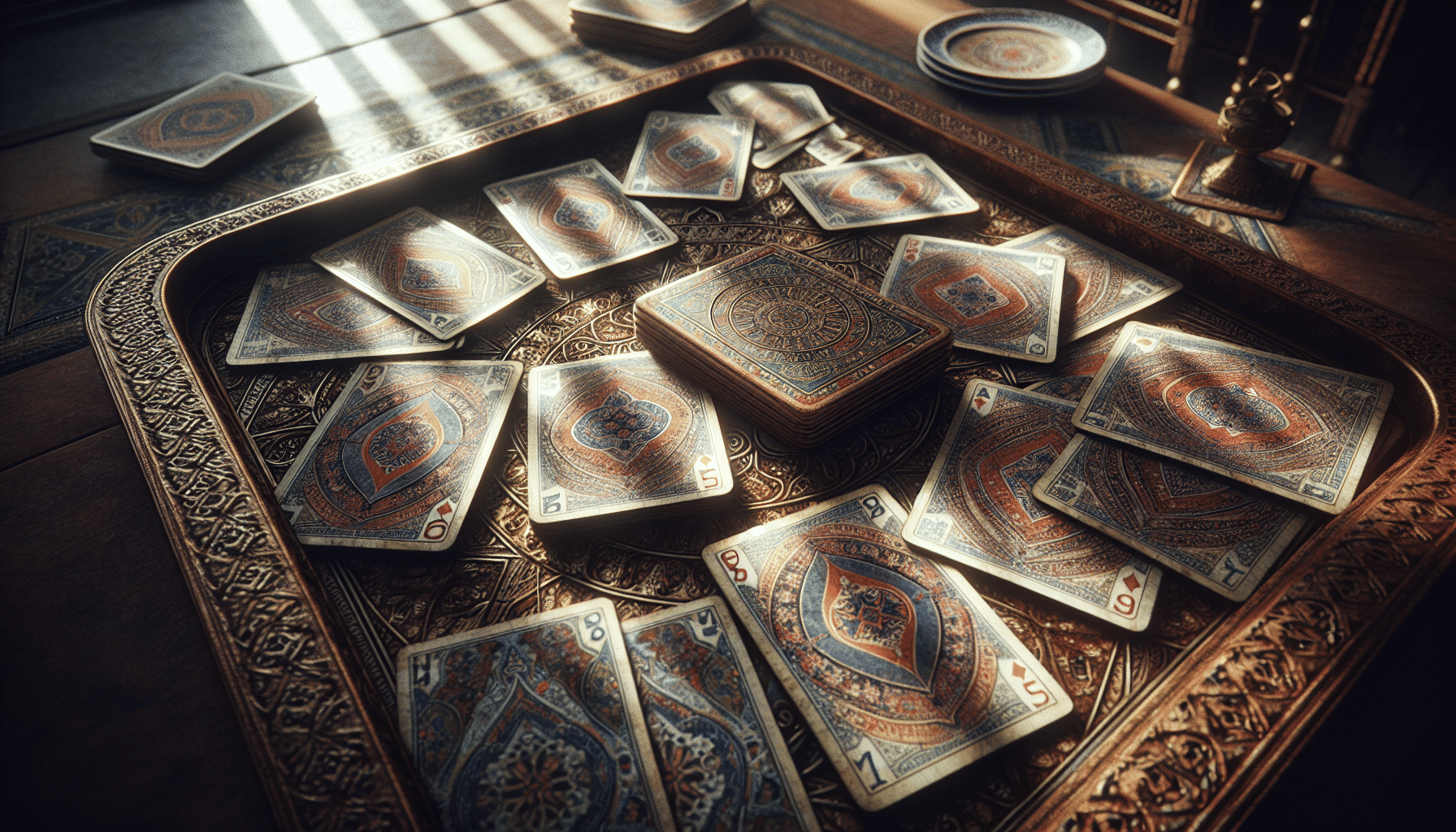
You’ll find a direct lineage between tarot cards and the 14th-century Mamluk card game, a predecessor with strikingly similar imagery and suits. When tracing the card games origin, the Mamluk culture stands out for its contribution to playing cards.
This historic connection is not merely coincidental; it’s a fascinating example of cultural exchange.
The Mamluk card game, played in the Islamic societies, didn’t just influence leisure activities; it shaped the very structure of modern card decks. Let’s compare some elements:
| Mamluk Cards | Tarot Cards |
|---|---|
| Cups | Chalices (Cups) |
| Swords | Swords |
| Coins | Pentacles (Coins) |
| Polo-sticks | Wands (Clubs) |
Each suit from the Mamluk deck has a counterpart in the Tarot, and later, in the standard 52-card decks you’re familiar with. It’s not just the suits, but the court cards too, that share a resemblance. The Tarot’s King, Queen, and Knight may very well have their roots in the Mamluk’s King, Deputy King, and Second Deputy.
Understanding this historical thread helps you appreciate the depth of tarot cards beyond divination. It’s a rich tapestry woven from the threads of ancient civilizations, bridging gaps between different cultures and eras.
Tarot’s Occult Transformation
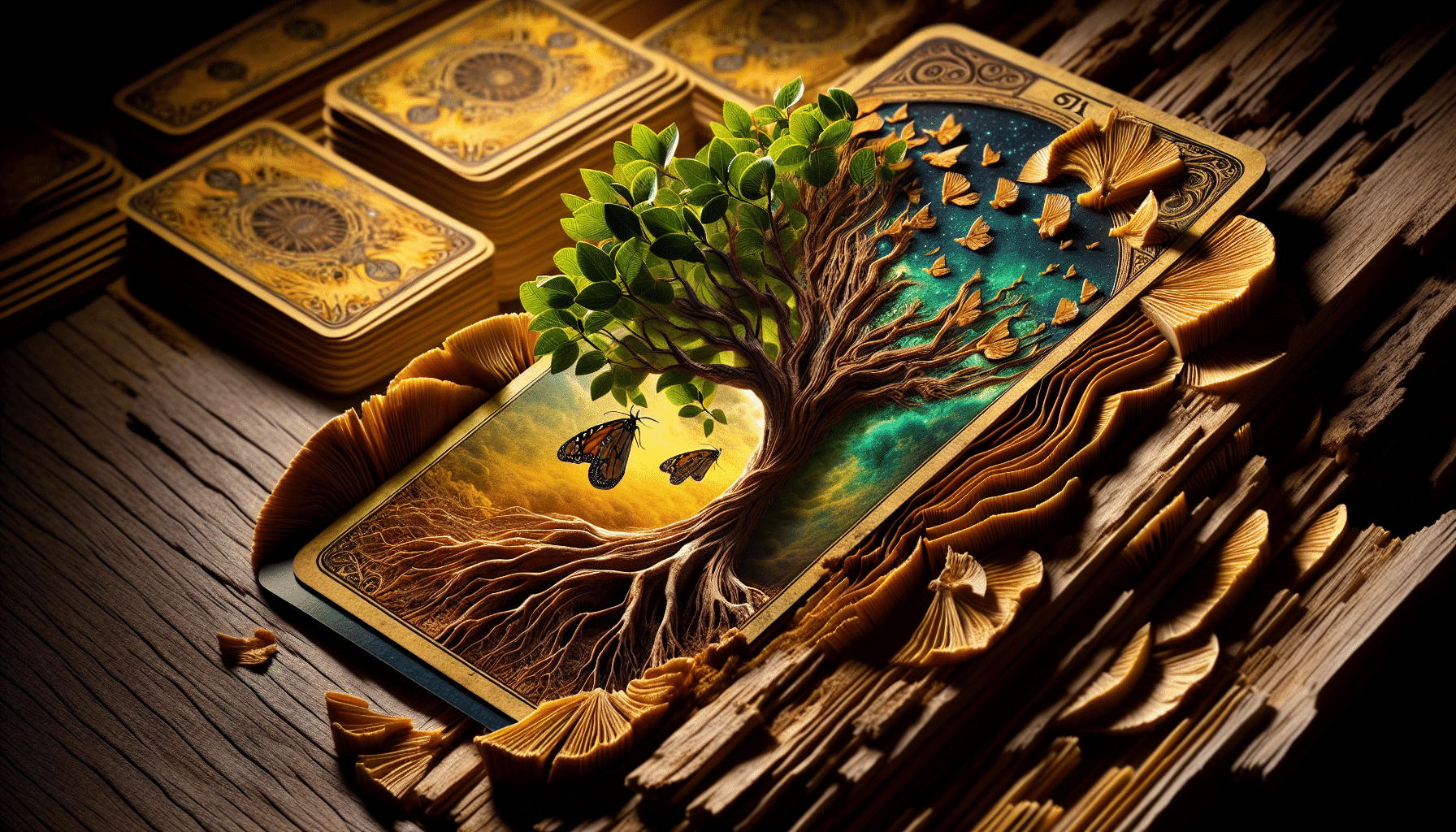
Discover how tarot cards underwent a mystical metamorphosis, transforming into a tool for occult practices and esoteric symbolism. Originally playing cards for games, their intricate imagery captured the attention of those seeking deeper meaning.
You’ll see that by the 18th century, tarot cards weren’t just for entertainment; they’d evolved into a profound method for divination and personal reflection.
Here’s how this transformation unfolded:
-
The Addition of Symbolic Meanings: Each card began to hold specific symbolic interpretations, with figures and scenes that were no longer just aesthetic but laden with philosophical and spiritual significance.
-
Adoption by Occultists: Visionaries and occultists embraced tarot cards as a means of accessing the subconscious and the divine. They developed complex systems linking tarot imagery to astrology, Kabbalah, and alchemy.
-
Codification in Literature: Texts like Antoine Court de Gébelin’s Le Monde Primitif theorized that tarots contained ancient, mystical wisdom, cementing their role in occult practices.
As you delve deeper, you’ll appreciate the layers of meaning each card holds. Tarot’s journey from courtly pastime to a cornerstone of occult practices is a testament to the human craving for understanding the unknown through symbolic interpretations.
The French Tarot Tradition
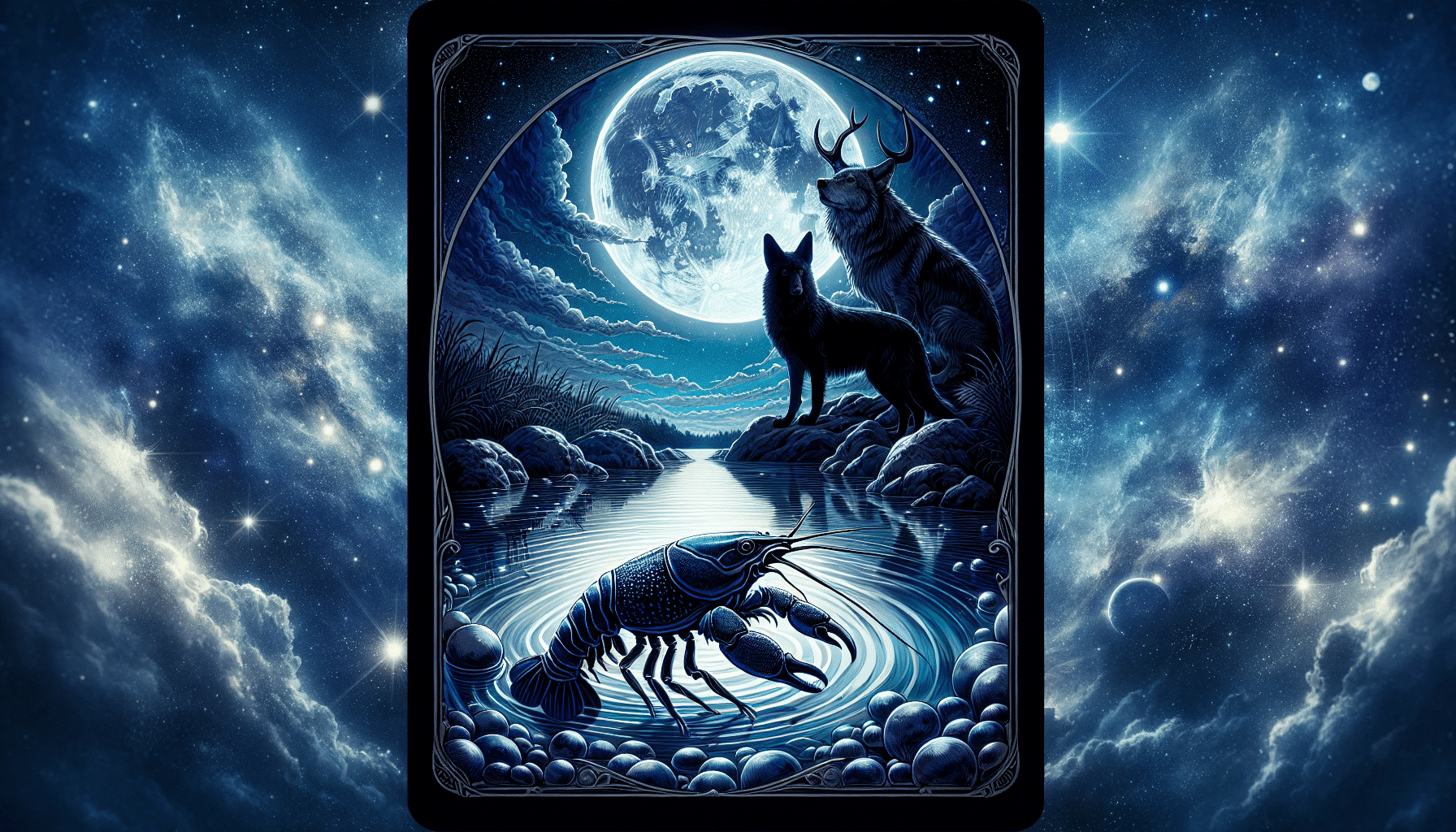
As you explore the evolution of tarot, it’s essential to recognize France’s pivotal role in shaping the tradition and use of these enigmatic cards. The French tarot tradition is rich and multifaceted, deeply intertwined with the history and culture of card playing in the region.
During the 16th and 17th centuries, the standardization of tarot with French suits – clubs, spades, hearts, and diamonds – marked a significant shift. This was a departure from the Italian suits, facilitating a broader acceptance and integration of tarot into French society.
Among the most renowned contributions of the French is the development of Marseille decks. These decks, named after the city of Marseille, a hub for card manufacturing, became a gold standard for tarot cards. Their distinct, intricate imagery and symbolism are recognized worldwide and have influenced countless modern interpretations of tarot.
You’ll find that the French tarot tradition isn’t just about mysticism or divination; it’s also about the artistry and craftsmanship that went into creating each deck. The Marseille decks exemplify this fusion of function and beauty, making them a cornerstone of tarot’s historical and cultural legacy.
Tarot in the Austro-Hungarian Empire
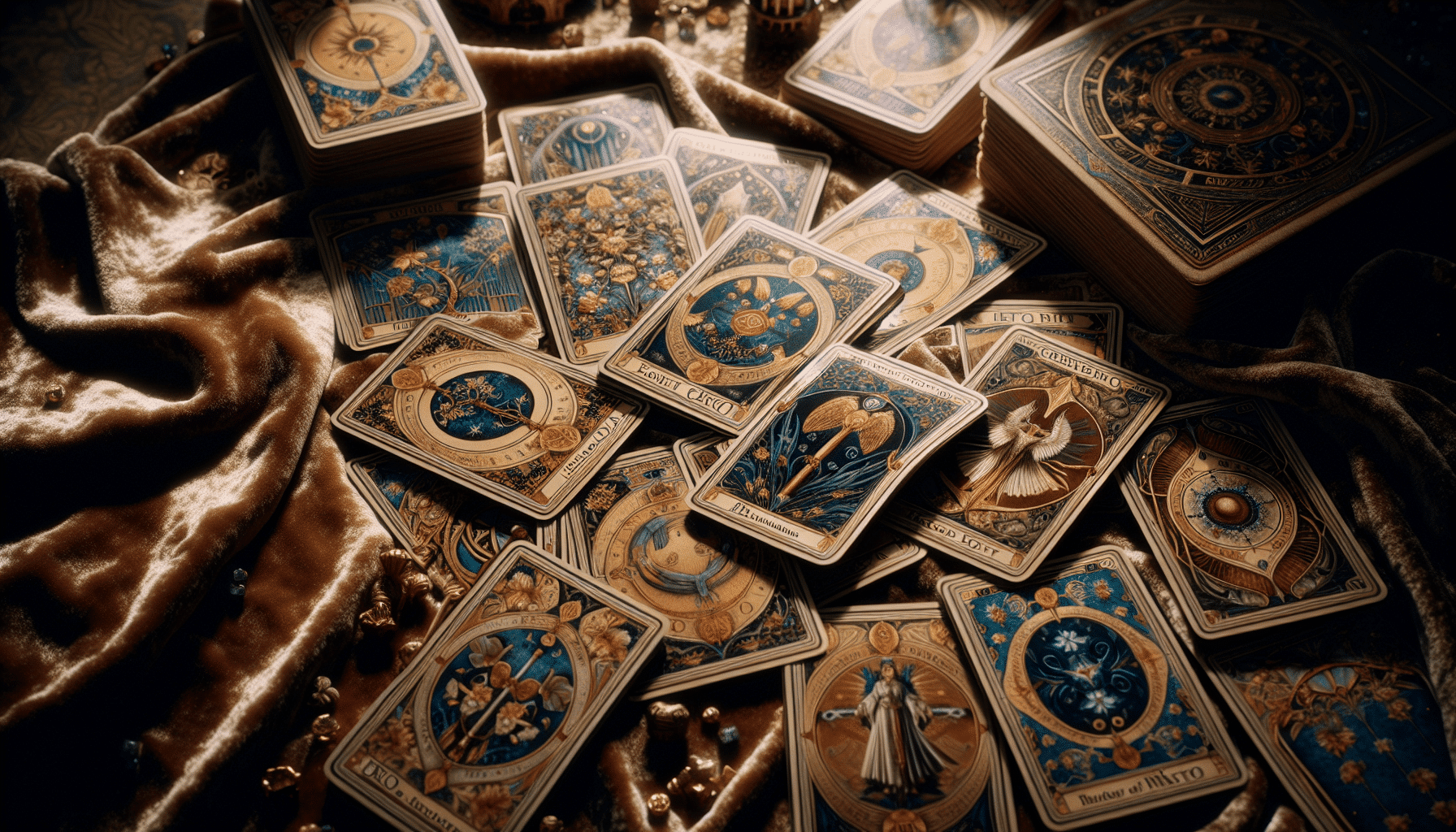
Beyond the French borders, tarot cards also found fertile ground in the Austro-Hungarian Empire, where they took on unique cultural significance and artistic expression. This region, known for its rich history and diverse cultures, embraced tarot in a manner that both adhered to and defied the Habsburg regulations of the time.
You’ll find that the imperial influence and the local customs gave rise to a distinctive tarot style and practices.
Imagine the tarot decks of the Austro-Hungarian Empire through these vivid elements:
-
Lavish baroque patterns and elaborate gold leafing adorning the cards, reflecting the grandeur of the Habsburg court.
-
Hidden symbols and coded imagery woven into the artwork, a nod to the secretive circles of Viennese mystics.
-
A blend of traditional tarot iconography with the Empire’s eclectic mix of cultural motifs, symbolizing the melting pot of the vast realm.
As a seeker of knowledge, you’d appreciate that while the Habsburg regulations often sought to control esoteric practices, the tarot found its way into the hands of those yearning for spiritual guidance and divination. Viennese mystics, in particular, were known to use the cards for their mystical readings, adding another layer to the rich tapestry of tarot’s history.
Rider-Waite-Smith Deck Evolution
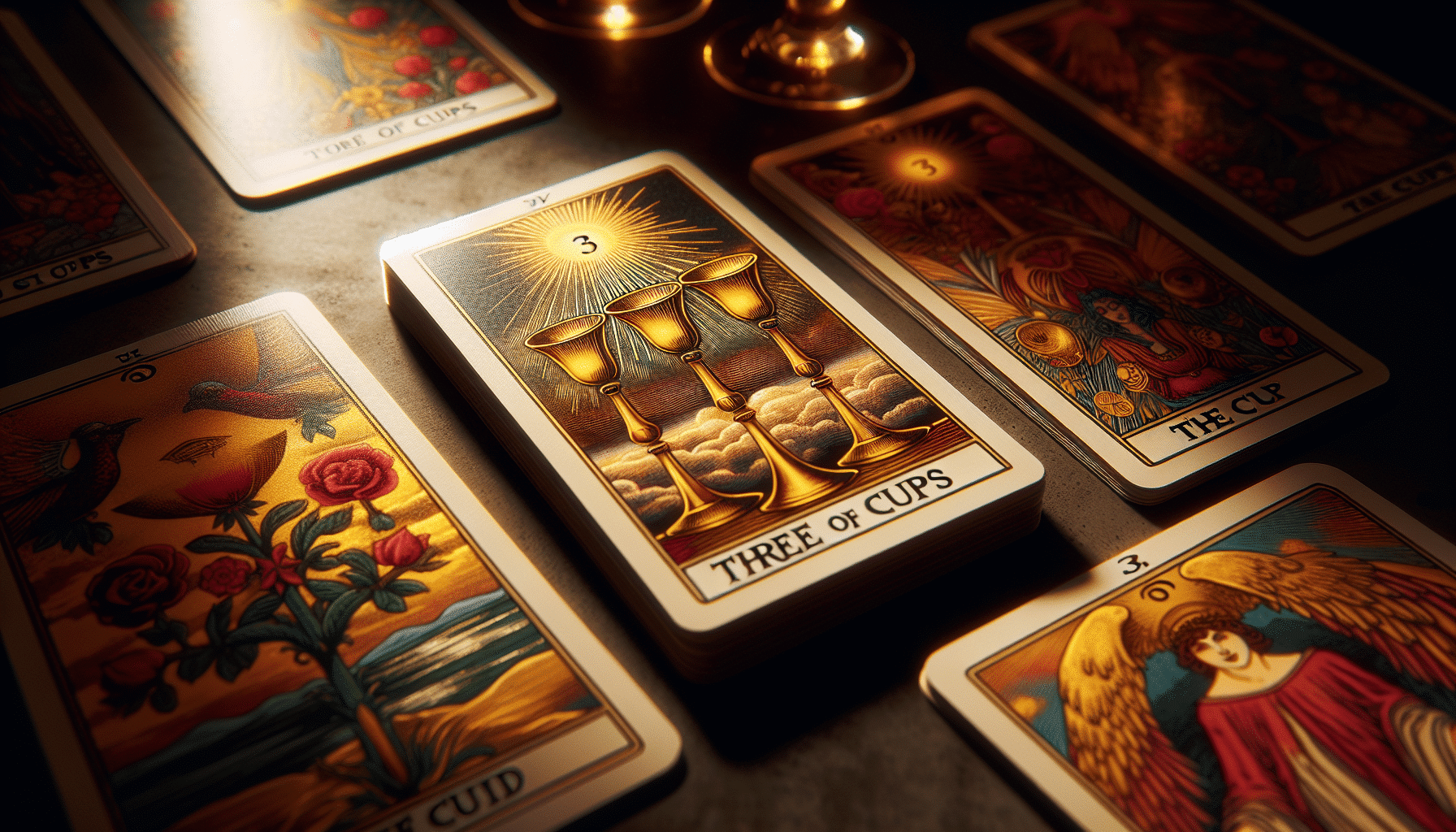
Transitioning from the lavishly adorned tarot of the Austro-Hungarian Empire, you’ll now encounter the Rider-Waite-Smith deck, a pivotal evolution that significantly shaped modern tarot practices.
The deck creators, Arthur Edward Waite, a member of the Hermetic Order of the Golden Dawn, and artist Pamela Colman Smith, embarked on a journey of symbolic reinterpretation that has left an indelible mark on the tarot world.
Waite’s vision was to create a deck with imagery that conveyed the esoteric knowledge of the Golden Dawn. He wanted the cards to be more than just tools for divination; he intended them to serve as a guide to mystical insight.
Smith, with her profound artistic talents, translated Waite’s concepts into evocative illustrations that were rich in symbolism. Together, they introduced a deck in 1909 that diverged from traditional tarot by featuring detailed pictorial images on the minor arcana cards, not just the major arcana.
This innovative approach allowed for a more intuitive reading experience, as each card’s meaning could be gleaned from the imagery itself. The Rider-Waite-Smith deck’s widespread adoption has made it a template for countless tarot decks that followed, ensuring its creators’ lasting legacy in the realm of the tarot.
Aleister Crowley and Thoth Tarot
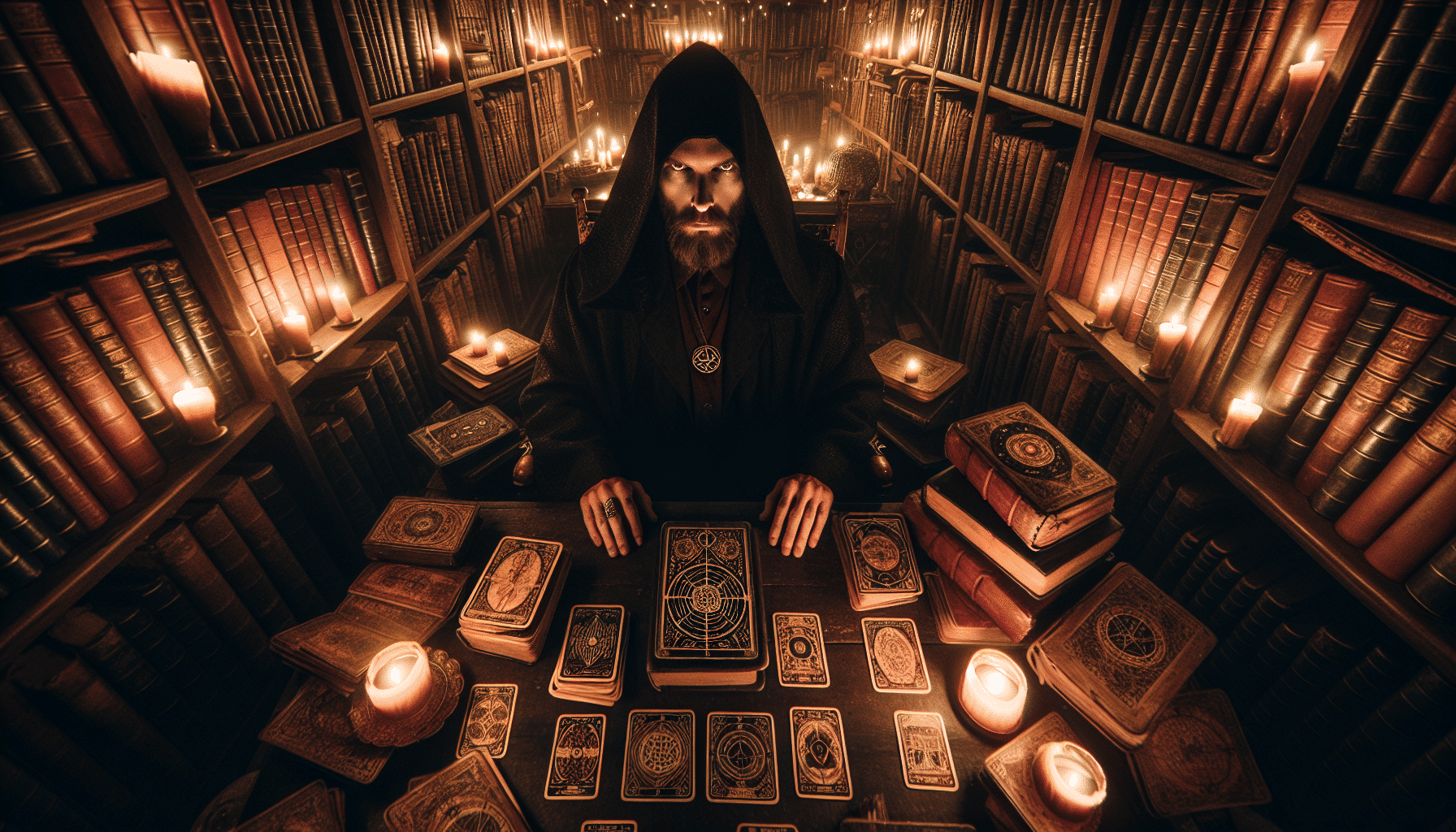
You’ve encountered the enigmatic world of Aleister Crowley, whose Thoth Tarot deck reshaped tarot philosophy.
Its intricate symbolism and Thelemic spiritual influence offer a distinct lens through which to interpret the cards’ meanings.
Now, let’s explore how Crowley’s legacy imprinted itself on the Thoth Tarot’s design and interpretation.
Crowley’s Tarot Philosophy
Aleister Crowley’s contribution to the Tarot comes through his Thoth deck, where he infused the cards with his own mystical and esoteric beliefs. His philosophy was deeply intertwined with his broader spiritual framework, Crowley’s Thelema, which emphasizes the discovery and fulfillment of one’s True Will. The Thoth Tarot is more than just a divination tool; it’s a visual embodiment of occult practices and Thelemic principles.
To visualize Crowley’s Tarot philosophy:
- The Priestess card draped in lunar mysteries, symbolizing intuition and the subconscious.
- The Universe card, encircled by the Ouroboros, representing the completion of one’s personal journey.
- The Magus, wielding the four Tarot suits, channels the elements and demonstrates mastery over the material world.
Understanding Crowley’s vision helps you see the Thoth Tarot as a map of the mystical path.
Thoth Deck Symbolism
Delving into the Thoth Tarot, you’ll uncover a symbolic tapestry where each of the 78 cards reflects Aleister Crowley’s profound occult knowledge. Crowley’s biography is deeply interwoven with this deck, displaying his fascination with the mystical and the esoteric. He was a prolific writer and magician of the early 20th century, known for his work in occultism and his founding of the Thelemic religion.
The Thoth Tarot is steeped in Egyptian mythology, with deities and symbols permeating its imagery. You’ll find nods to ancient concepts of the universe and spiritual evolution, a testament to Crowley’s belief in the interconnectedness of various mystical systems.
As you explore these cards, you’re engaging with a visual representation of Crowley’s legacy and the enigmatic wisdom of the ages.
Thelemic Spiritual Influence
Understanding of the Thoth Tarot deepens as you consider its Thelemic spiritual roots, which are central to grasping the deck’s full esoteric significance. Aleister Crowley, its creator, was a ceremonial magician and prophet of Thelema, a spiritual philosophy that emphasizes the individual’s will. His deck is infused with Thelema fundamentals and designed to be a tool for Magick practice.
To visualize the intertwining of the Thoth Tarot with Thelema, picture the following:
- The intricate symbolism on each card, reflecting Thelemic deities and concepts.
- Rituals and spreads specifically developed for Thelemic followers, becoming mediums for self-discovery.
- The card’s images, teeming with astrological, numerological, and Kabbalistic references that align with Thelemic teachings.
This deck isn’t simply for fortune-telling; it’s a guide for personal evolution within Thelema’s mystical framework.
Tarot During the Victorian Era
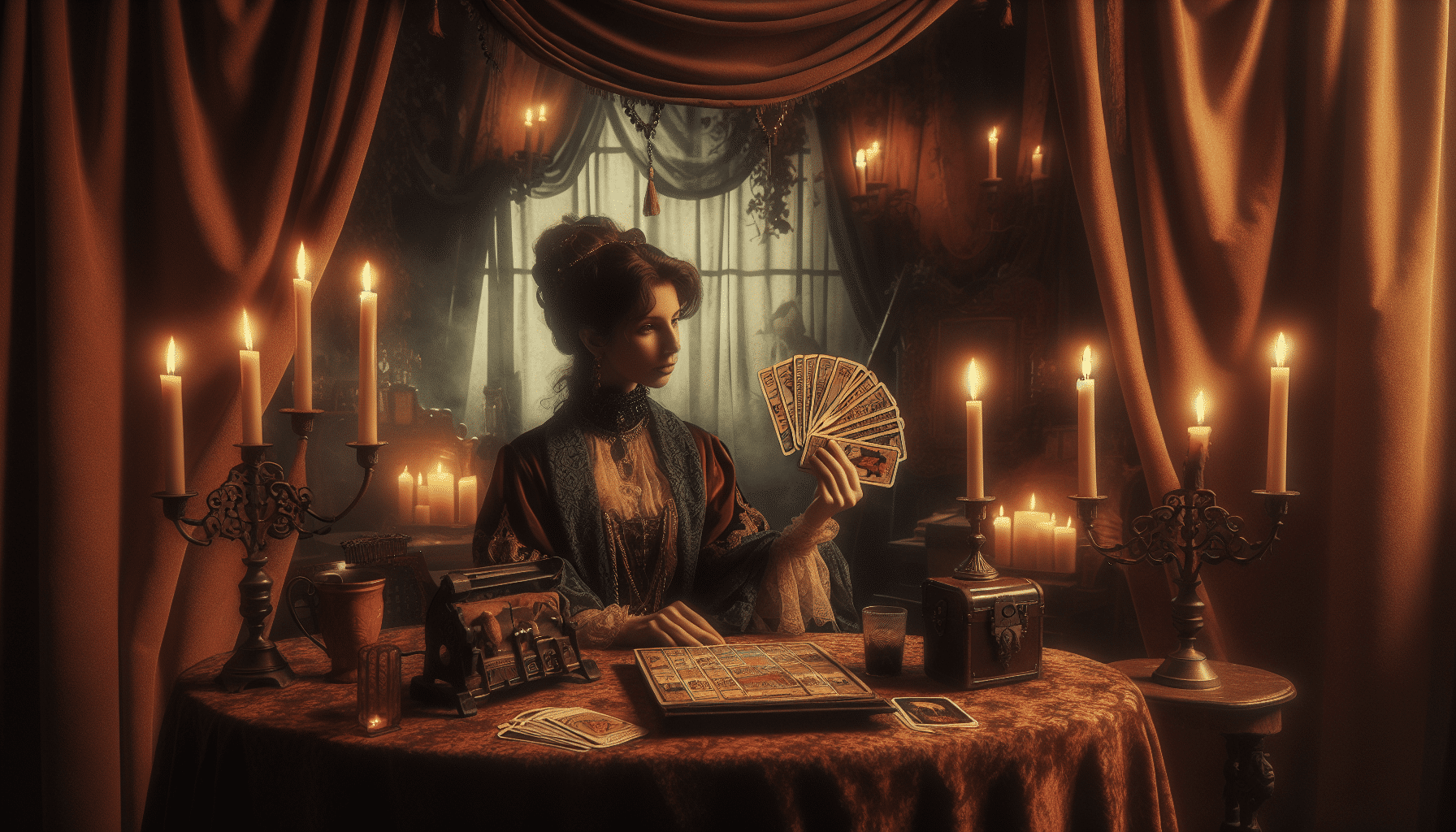
In the Victorian era, numerous mystics and intellectuals embraced tarot cards as tools for divination and personal insight. Despite the strict Victorian morality that emphasized rationalism and propriety, a surge in Spiritualism challenged the status quo. People were fascinated with the occult, seeking connections with the afterlife and hidden knowledge.
Tarot cards, with their rich symbolism and potential for storytelling, fit perfectly into this cultural moment. They offered a way to explore the unknown, providing a sense of guidance and reflection that many found lacking in traditional religion or science. You’d likely have seen tarot readings at private salons or in the quiet corners of gardens during this time, as individuals sought personal enlightenment and a deeper understanding of the world around them.
The beauty of tarot during this period wasn’t just in its use for prediction. It became a mirror for the self, a way to navigate personal dilemmas and societal pressures. You might’ve used the cards to tap into your subconscious, finding in their images a language that spoke beyond words.
In a time of both skepticism and belief, tarot carved out a unique space where the mystical and the everyday could coexist and enlighten.
Tarot’s Popularization in the 20th Century
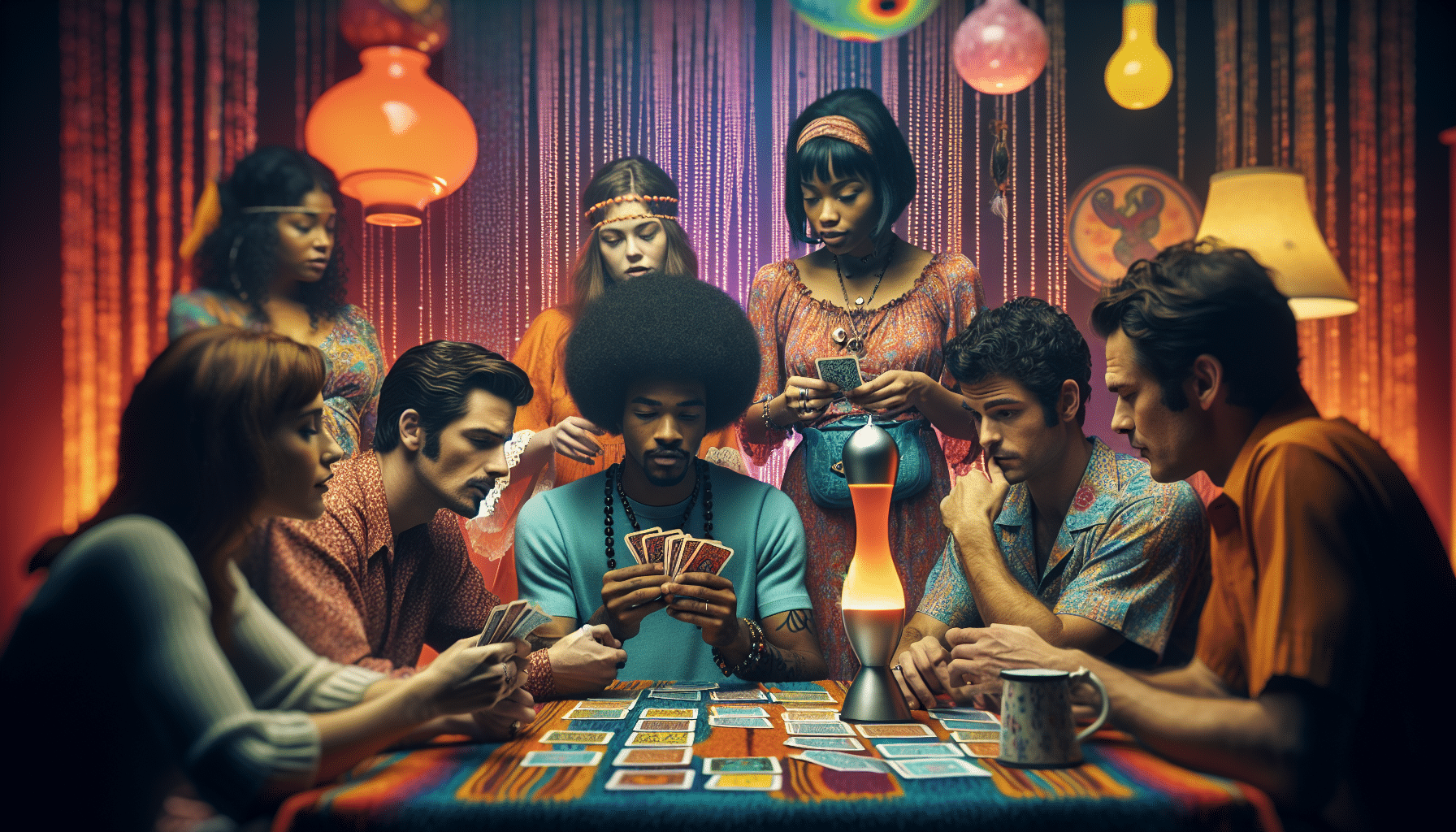
Having explored the mystical allure of tarot in the Victorian age, you’ll now see how the 20th century brought these enigmatic cards into mainstream culture like never before. Tarot’s cinematic portrayal played a significant role in this popularization. Films and television shows weaved tarot imagery and readings into their narratives, creating a sense of intrigue and otherworldliness that captivated audiences worldwide.
Celebrity tarot enthusiasts also contributed to the cards’ rise in popularity. High-profile figures openly consulted tarot readers and sometimes incorporated tarot practices into their personal brands, further normalizing the cards and sparking public interest.
To paint a picture of tarot’s ascent in the 20th century, consider these three vivid scenes:
- A smoky, dimly-lit room where an enigmatic figure lays out tarot cards, foretelling a protagonist’s fate in a critically acclaimed movie.
- A world-famous musician raving about their life-changing tarot reading during a televised interview, inspiring fans to seek their own readings.
- A best-selling book on tarot flying off the shelves, providing easy-to-understand interpretations that make the art accessible to the curious and the skeptical alike.
Together, these elements wove tarot into the fabric of 20th-century culture, transforming it from a niche mystical tool to a widely recognized and embraced phenomenon.
Digital Age and Modern Tarot

Exploring the world of tarot in the digital age, you’ll discover how online platforms and mobile apps have revolutionized the way people engage with these ancient cards. No longer do you need a physical deck to delve into the wisdom of tarot; digital predictions are readily available at your fingertips. Online spreads have simplified the process, bringing the mystique of tarot into the modern era.
The convenience of tarot apps means you can seek guidance anywhere, anytime. With a simple tap, you can shuffle virtual cards and receive interpretations that once required a seasoned tarot reader. The digital transformation has not only made tarot more accessible but also allows for a personalized experience as you can often save readings and track your spiritual journey over time.
Here’s a quick overview of the changes:
| Traditional Tarot | Digital Tarot |
|---|---|
| In-person readings | Online spreads |
| Physical cards | Virtual decks |
| One-time interpretation | Saved readings history |
| Local reach | Global accessibility |
You’re part of a community that spans the globe when you tap into tarot’s digital realm. Whether you’re a novice or a seasoned reader, modern tarot offers a world of possibilities that transcends time and space.
Conclusion
You’ve now journeyed through the rich tapestry of tarot’s past, from its enigmatic origins to its digital age revival. Like an ancient river that continues to flow into modernity, tarot cards have meandered through culture and time, evolving yet holding onto their mystical allure.
As you shuffle your deck, remember the centuries of history in your hands, a blend of art, symbolism, and mystery that continues to captivate and enchant to this day.
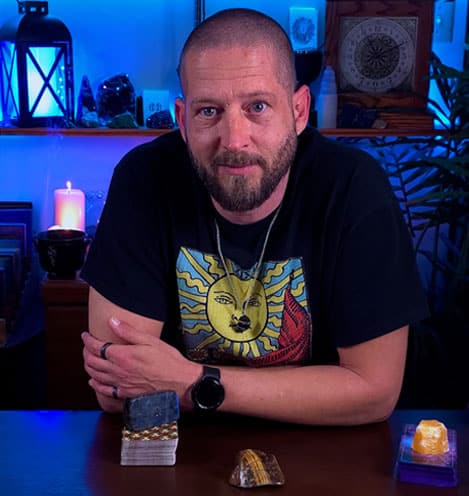
About The Author – Allen Hill
Allen Hill, the force behind Unknown Truth Tarot, has a YouTube following 6-times bigger than the population of his hometown, Miamisburg, Ohio. From his spiritually rich blog on Tarot and crystals to his role as CEO of The Unknown Truth Tarot Metaphysical Shop, Allen’s passion for the metaphysical shines through.
A master Tarot reader and “crystal junkie,” Allen is also a devoted dad to Dylan, 10, and Destiny, 24. When he’s not immersed in the world of Tarot and crystals, he enjoys poker and video gaming sessions, often humorously outplayed by Dylan.
Follow Allen on Twitter, Instagram, Facebook, TikTok, and subscribe to his Unknown Truth Tarot YouTube channel to join him on a journey of spiritual growth and self-discovery.

